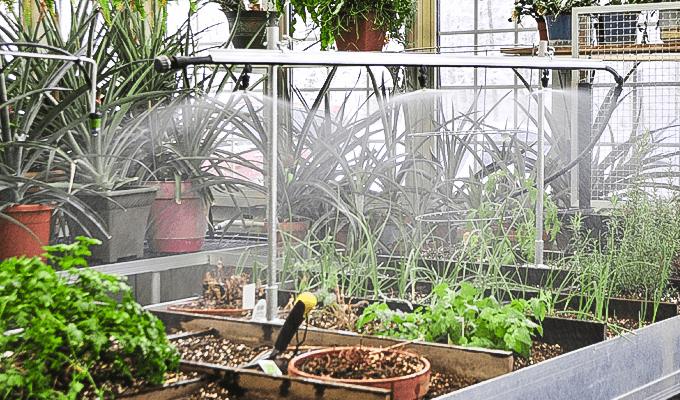Overheating of the greenhouse during the summer months is a common but unnecessary problem. Your greenhouse can and should be a comfortable and refreshing place for you and your plants to enjoy on those hot summer days.
Keeping the greenhouse cool is accomplished by obtaining a proper balance of shading, ventilation and humidity. Following are some guidelines.
Greenhouse Ventilation
Traditional ventilation systems of ridge or end vents work well if they are large enough and oriented to take advantage of prevailing winds. The upper vents should be equal in size to 15% of the floor area. In addition, there should be vents in the lower walls equal to 10% of the greenhouse floor area. A typical 8′ x 12′ greenhouse would have 15 sq. feet of roof vents and 10 sq. feet of lower vents. The roof vent should open 45° above horizontal. These vents can be operated by hand, or by non-electric solar powered pistons.
Thermostatically controlled exhaust fan systems are a popular alternative to traditional roof vents. The fan uses very little electricity, and the thermostat makes the system automatic and easily adjustable to various operating temperatures. The thermostat is usually set at 75° to 80° F.
The proper size fan will change the air in the greenhouse in about 1½ to 2 minutes. Determine the volume of your greenhouse (Length x Width x Average Height) and multiply by 0.75 to obtain the ventilation rate in Cubic Feet per Minute (CFM). (For Average Height, measure halfway up a roof rafter and then measure straight down to the floor. This vertical measurement is the Average Height.)
To enable the exhaust fan to operate effectively, fresh air intake shutters must be provided in the opposite end of the greenhouse. The shutters are opened by the flow of air drawn into a greenhouse by the fan, or they can be opened and closed by a shutter motor. Determine shutter size by dividing the fan CFM by 250 which will give you shutter size in square feet. If more than one shutter is to be used, divide this figure by the number of shutters to obtain the area of each shutter. (Two shutters are recommended for greenhouses over 100 sq. ft. or wider than 8 feet.)

Greenhouse Misting
Shading and ventilation will prevent the greenhouse from seriously overheating, but it is evaporation of moisture inside the greenhouse that will actually cool the greenhouse. Evaporating water soaks up heat like a sponge because heat is used when water changes from a liquid to a gas. Good air circulation from fans increases evaporation.
The amount of moisture necessary to cool the greenhouse will vary considerably depending on the amount of ventilation and shading provided, the local climate, and daily weather changes. Generally, 1 to 2 gallons per hour for each 10 square feet of floor area will provide enough moisture. A good misting system will disperse the water evenly around the greenhouse in a fine mist without soaking the plants.
There are several ways to provide moisture in the greenhouse and the most common is to soak the floor with a sprinkler hose. Water can be stored for slow release in pea gravel on the greenhouse floor. But an automatic system of misting nozzles is more accurate and reliable. A humidistat set at 60% to 70% relative humidity will keep most plants comfortable and provide plenty of moisture for evaporation through the mist nozzles. The location of the nozzles can vary. They can be mounted under the benches, especially in front of the fresh air intake vents.
Apply mist only during daylight hours to avoid excessive humidity at night, which encourages disease. Remember; when the greenhouse cools at night, the relative humidity will rise even with the misting system off so use a 24-hour timer to shut off the misting system 2 hours before sundown.
Greenhouse Shading
Install shading to shield the greenhouse or sunroom from excess sun between 9 a.m. and 5 p.m. and severe western exposure may require shading until 7 p.m. Shading should cover the roof and at least the upper half of the south wall. The amount of shading needed (expressed as a percentage of light blocked) will vary depending on your local climate, greenhouse design, and light requirements of your particular plants. Use the least amount of shading necessary, because excessive shading can slow plant growth of cause plants to “reach” for more light. The following list can be used as a general guide to shading density:
- 30% Snapdragons, Chrysanthemums, Geraniums, Vegetables
- 40% Lilies, Bedding Plants, Caladiums
- 50% Azaleas, Begonias, Camellias, Gloxinias, African Violets, Poinsettias
- 55% Pachysandra, Ivy, Orchids
- 60% Dieffenbachia, Stag Horn Fern, Rhododendron
- 70% Fern, Anthurium, Dracaena, Philodendron
- 75% Palm, Chinese evergreen
A light meter is a valuable tool in obtaining the proper degree of shading, as well as determining winter lighting requirements.
Shading is 40% more effective when installed on the outside of the greenhouse. Allow air circulation by suspending the fabric 4″ to 9″ above the glazing surface.
Evaporative Coolers (Swamp Coolers)
A supplement to the misting system is an evaporative cooler. It works well in dry climates where the humidity is below 50%. Air is cooled 10° to 20° F by water evaporation as it is drawn through the cooler and into the greenhouse.
Carol Yaw is the Co-Owner of Charley’s Greenhouse & Garden. You can visit their website at CharleysGH.com.
Related Articles & Free Email Newsletter Sign Up
How to Choose the Right Size, Location, and Type of Greenhouse
How to Ensure Proper Ventilation in your Greenhouse
Why Proper Ventilation Helps Create a Healthy Greenhouse




Comment here